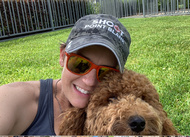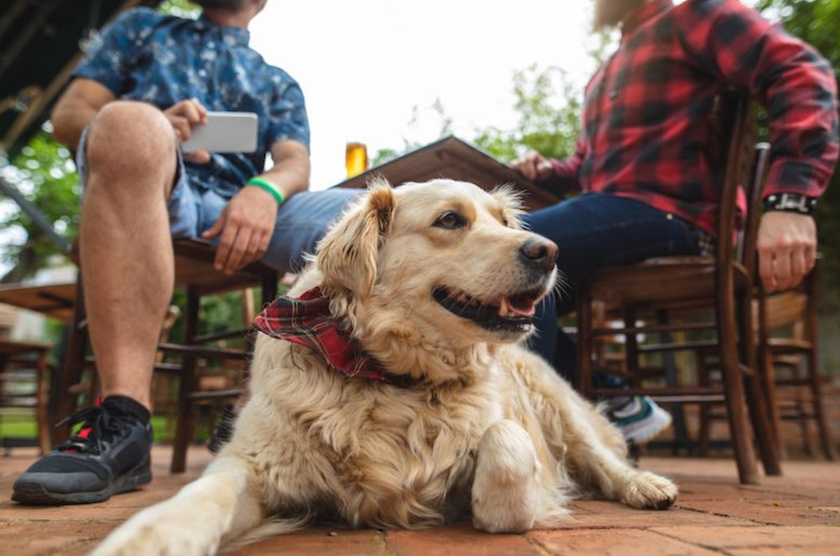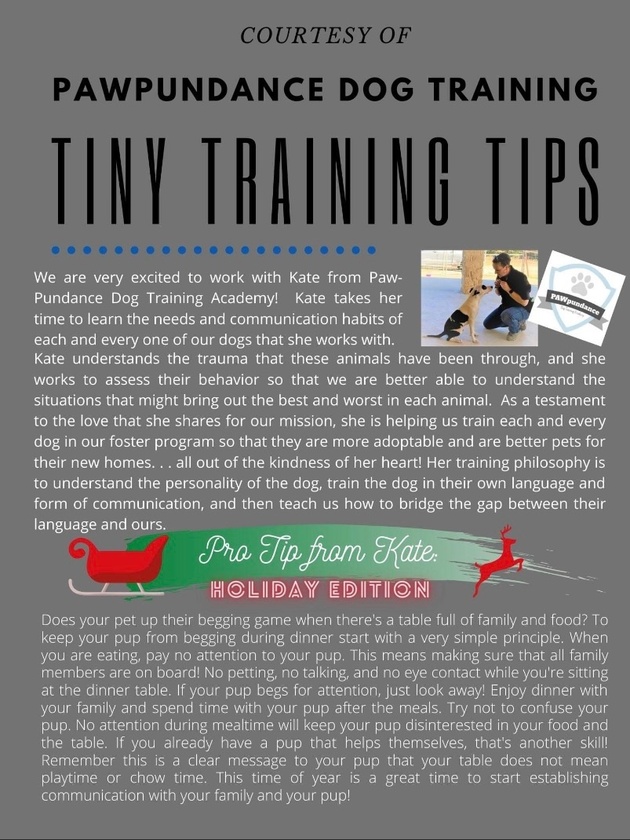
It’s ok! We’re here to help. We speak a little dog and can help translate for both of you. It’s probably just a miscommunication! And we are here to help get you both speaking the same language! Woof!
Connect with the PAWpundance training team and other members of the dog community to discuss better ways to communicate with your furry house guest.
**To get started USE code: TRIAL1month **
We worked with Tink, who was one smart cookie, on impulse control exercises.
Tink was working on recovering from an attack, where she was injured by a white German Shepherd in her home. The pup was a foster and things clearly got out of hand. Tink had the impulse to herd other dogs and was a little bossy. She didn't always respond well to other dogs communication to back away. She had always been the sweetest pup and extremely well socialized in the human world, but sometimes being humanly socialized can leave pups at a disadvantage as they never learn health canine communication. Many times, like with Tink, they end up in situations that can become dangerous. While I can't speak to the whole situation - and I certainly can't condone Tink's injuries, I see this happen a lot in the dog parks. One pup speaks dog very clearly and asks for distance. The other is pushy and is better in a human world - to the extend they expect the humans to back them up. The other dog uses growling to bearing teeth to barking to nipping and all the moving and posturing to show they are uncomfortable. And still the human-adjusted pup blatantly continues to persist. And when I'm there, I remove the human-adjusted pup, not the growling dog. The growling dog can't be "punished" for speaking dog. However it's so often the case. Many times the owner of the growling dog will just shout or try to "Cesar Milan" and man-handle the dog to show they are the "pack-leader". But I try to remove the instigator and that's usually the pup that just doesn't speak dog well. In my case, it's usually the dog I'm working with and why I'm in the park.
With Tink, she needed to have a moment to process the world around her before she reacted to every thing that jumped out at her. And after her attack, she was scared of all dogs. Her fear manifested in a raging bark toward every dog. To explain thing to family members that could not grasp how scared Tink felt - and it was like a panic attack - I asked them to imagine a rape victim (woman) to go into a college bar. Wouldn't that woman feel every man is a threat immediately following the attack. It would take time for that woman to feel safe in a room full of men again, right? Tink was attacked and felt every dog was a threat. She lashed out. It took time for her to feel comfortable with other dogs. But to have to space to realize the other dogs weren't threats, she needed to get to know individual pups to see there were safe dogs and be able to accept the world, learn good communication and to see the dog that attacked her was an outlier. He was just more aggressive. He probably had his own scary event that made him a little "damaged" and he did not react well to her. She was on track to being like him. But someone loved her and was going to help her.
We started with basic leave it/take it. Tink was really good at catching things in mid air. So in this video we took the leave it/take it to a new level. We called it midair.
We started with leave it where we just drew the imaginary line that she couldn't cross. This exercise is all about a body block. If my body in any way crosses the direct line between the pup and "reward", it's blocked. If I drop an onion in the kitchen while I'm cooking and I see my pup making a beeline for the onion. We don't have to race down to see who will get to the onion first, I simply need to put my foot in their path on that imaginary line. I can reinforce it with a "leave it". Eventually the body block becomes less invasive and it can become more subtle. Small leans into direction and cause your pup to stop or yield.
Once you get to the point where your movements are more nuanced and your pup is responding, many doors open up. Another exercise, "walk away" will be really helpful for your one-on-one connection, but having your pup responding to your movements is pretty neat.
But how does this help Tink with her emotional journey? She needs space. She needs that moment between that scary "ah" and her reaction to it. She needs a moment to think and respond to it instead of having a fear-based reaction. We teach her impulse-control skill in the safety of her home to supplement the behavioral training which will involve more friction. The impulse control exercises help the accelerate the CC&D (counter conditioning and desensitization), BAT (Behavior Adjustment Therapy) etc.
All in all, watching Tink go through all this was amazing and we are so proud of her. She really blossomed and she's a very smart cookie. It takes a lot to come through an attack like hers. So we are very impressed by this pup! Way to go Tink!!
Welcome to PAWpundance Dog Training Academy on Locals.com!
We’re thrilled that you’ve joined our community! PAWpundance is a place for positive, dog-loving people to come together, share experiences, and help each other grow. Locals offers an “ad-free experience,” so even a small contribution helps support our tech and keeps our community thriving.
We want to see your furbabies!
We’re here to assist with any questions you may have about training, behavior, and more. At PAWpundance, we believe in blending knowledge with a bit of fun—expect plenty of paws, puns, and maybe even a dance or two! Together, let’s enjoy some laughs and build stronger relationships with our pups.
Our Philosophy:
We’ve invited another species to live in our homes, and our dogs are much more than accessories; they’re our guests. They don’t speak our language, and like in the movie E.T., we don’t want to be the intimidating figures trying to coerce a scared, confused being. Instead, we want to be like ...
Eye Contact, Eye Contact, Eye Contact!
Reward every glance. Start by reinforcing brief glances, then encourage your pup to hold your gaze a bit longer. Gradually phase out your part of the eye contact—your pup will learn to watch you and adapt to your movements naturally. This approach helps them learn to walk with you without relying on leash cues.
Remember, the leash is purely for safety—not for communication.
Take a look at this video with Meghan and Buckee. Buckee is watching Meghan closely, and she rewards him by making eye contact, smiling, and offering treats. Meghan also looks forward occasionally, teaching Buckee to walk with her in sync.
Notice that Buckee is a reactive pup, so the leash is essential for safety, especially if he responds to something unexpectedly. However, it’s only used for physical control when necessary. When Buckee refocuses, Meghan reestablishes instructional control, and they continue their walk together. She does a fantastic job of engaging with him! In ...
Loose-Leash Walking Tip:
Where you reward makes a big difference! Try using the hand on the same side as your dog when giving treats or praise.
When you reach across your body to reward with the opposite hand, it draws your dog’s nose in front of you, encouraging them to move ahead and potentially start pulling.
In the video of Meghan and Domino, Meghan holds the leash with her left hand while Domino walks on her right. She rewards him by petting and giving treats with her right hand. This keeps Domino walking by her side on a loose leash, rather than in front, pulling her along.
Next time you’re out walking with your pup, try rewarding with the hand on the same side as your dog.
https://twitter.com/wholedogjournal/status/1295508215740932098?s=21
How to teach you pup to be a good dining companion! What a great skill!

https://twitter.com/wholedogjournal/status/1292609106637987840?s=21
This is about counter-surfers, but I love the description of trying to shame dogs. This author, Pat Miller helped me understand this concept in her book the Power of Positive Dog Training.
If you’re still on Twitter, the Whole Dog Journal is a great group to follow. Lots of fantastic info!













